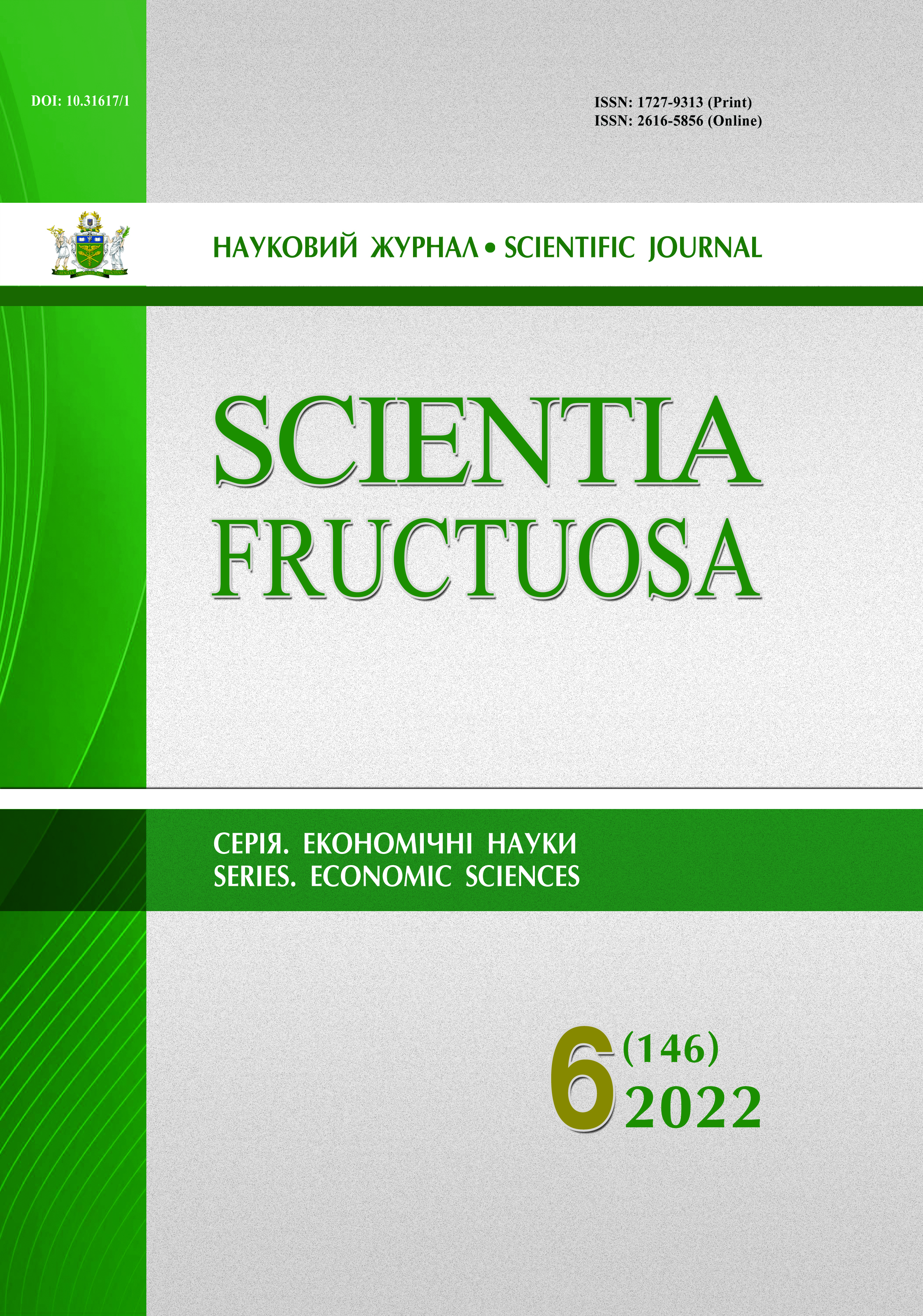Групи продуктів з удосконаленим ринковим доступом і покращеним експортом
DOI:
https://doi.org/10.31617/1.2022(146)02Ключові слова:
експорт, імпорт, доступ на ринок, торгівля, нетарифні заходи, ПВЗВТ, регуляторні бар’єри, система інфраструктури якості ЄС, продукти та сектори УкраїниАнотація
Вступ. Результати діяльності України в рамках Угоди про асоціацію між ЄС та Україною, включаючи положення про поглиблену та всеосяжну зону вільної торгівлі (ПВЗВТ), покращання доступу до ринку означають не тільки зниження тарифів, а й зменшення нетарифних заходів шляхом узгодження з правилами ЄС.
Проблема. Конкуренція між правилами приводить до зближення стандартів на практиці. Однак питання про те, чи можуть національні відмінності продовжуватися, є емпіричним.
Метою дослідження є визначення взаємозв’язку між групами товарів з покращеним доступом та експортом у контексті європейських перспектив подальшого розвитку України.
Методи. Використано загальні та спеціальні методи дослідження.
Результати дослідження. Обґрунтовано, що український бізнес може підвищити продуктивність та ефективність своєї діяльності завдяки прийняттю стандартів ЄС на 13–30 %. Встановлено, що менша частка імпорту в загальному імпорті конкретної країни означала б більші торгові витрати в цій країні для країни-експортера, і навпаки. Ідентифіковано всі продукти з кодами HS4, частка ринку яких в ЄС менша, ніж на світовому ринку. Виявлено неефективну продукцію в рамках ПВЗВТ. Для ідентифікації цих продуктів запропоновано спеціальну формулу. Запропоновано економіко-математичний підхід до оцінювання зростання експорту в умовах безконфліктності торгівлі.
Висновки. Тарифи самі по собі не є єдиною перешкодою для входу на ринок ЄС. Деякі з найбільших витрат на торговельні операції вважаються основною перешкодою для розвитку експорту, який розглядався в рамках ПВЗВТ. Подальші дослідження можуть бути зосереджені на оцінці конкурентоспроможності продуктів із покращеним доступом.
Посилання
Matthews, A. (2003). Regional Integration and Food Security in Developing Countries. Rome, Food and Agriculture Organization of the United Nations. https://www.fao.org/3/y4793e/y4793e05.htm#fn7 [in English].
Duginets, G., Diachenko, O., Mazaraki, N., & Golovachova, O. (2019). Deep and comprehensive free trade agreement with the EU: advantages and downsides for the Ukrainian society. Ed. Ganna Duginets. Kyiv: Kyiv National University of Trade and Economics [in English].
VOŠTA, ILAN & U IYENK, ITLANA & ABR Á, J EF (2016). Ukraine-EU Deep and Comprehensive Free Trade Area as Part of Eastern Partnership initiative. Journal of International Studies [in English].
Petrov, R. (2018). The impact of the EU-Ukraine association agreement on consti¬tutional reform and judicial activism in Ukraine. Review of Central and Central East European Law, 43 (2), 99-115 [in English].
Rabinovych, M. (2022). EU-Ukraine "deep" trade agenda: the effectiveness and impact perspectives. Int Polit. https://doi.org/10.1057/s41311-022-00384-x [in English].
Baležentis, О., & Yatsenko (2018). Trade Integration As etries of Ukraine and the EU. The Journal of International Economic Policy, 1(28), 33-63. http://iepjournal.com/journals_eng/28/2018_2_Basenentius_Yatsenko.pdf [in English].
Hlibko, S., Matyushenko, I., & Petrova, M. (2020). Assessment of the development of foreign trade in high-tech production of Ukraine under the association with the EU. Business Management and Education. Vol. 18. Issue 1, (pp. 157-182). 10.3846/bme.2020.11578 [in English].
Shnyrkov, O., Rogach O., Reznikova N., & Nanavov A. (2020). Ukraine’s export diversification: the impact of economic integration and disintegration. Journal Global Policy and Governance. Vol. 9. Issue 1, (pp. 3-18). https://transitionacademiapress.org/jgpg/article/view/297 [in English].
Hellyer, M., Piatnytskyi ,V., & Piatnytska, G. (2021). Effect of Tariff Liberalization under the DCFTA with the EU on Ukraine’s Extensive Margin of Trade. International Journal of Entrepreneurship. Vol. 25. Issue 3, (pp. 1-13). https://www.abacademies.org/articles/effect-of-tariff-liberalization-under-the-dcfta-with-the-eu-on-ukraines-extensive-margin-of-trade.pdf [in English].
MATTOO, A., & FINK, C. (2002). Regional Agreements and Trade in Services: Policy Issues, World Bank Policy Research Working Paper 2852. June. https://doi.org/10.1596/1813-9450-2852
Mattoo, A., & Fink, C. (2004). Regional Agreements and Trade in Services: Policy Issues. Journal of Economic Integration, 19(4), 742-779. http://www.jstor.org/stable/23000721 [in English].
Schiff, M., & Winters, A. (2003). Regional Integration and Development. Washington, D.C., World Bank and Oxford, Oxford University Press [in English].
Mangelsdorf, A., Ferro, E., & Wilson, J. S. (2014). The Trade Impact of European Regulatory Standards for Developing Countries. European Trade Study Group Conference [in English].
AFNOR (2009). The Economic Impact of Standardization – Technological Change, Standards and Long-Term Growth in France. Paris [in English].
DIN (2000). Economic Benefits of Standardization. Vol. 3. Berlin: Beuth [in English].
DTI (2005). The Empirical Economics of Standards. DTI ECONOMICS PAPERS, 12. London [in English].
RONEN, Eyal (2017). Quantifying the trade effects of NTMs: A review of the empirical literature. Journal of Economics and Political Economy. Vol. 4. Issue 3. September [in English].
GRUEBLER, J., GHODSI, M., & STEHRER, R. (2016). Assessing the impact of non-tariff measures on imports. The Vienna Institute for International Economic Studies [in English].
Hellyer, M. (2021). Effectiveness of European integration provisions for Ukraine’s Exports. Dissertation of obtaining a scientific degree of PhD in specialty 292 – International Economic Relations. Kyiv [in Ukrainian].
ANDERSON, JAMES E. (2019). Trade, Size, and Frictions: the Gravity Model. NBER Working Papers, January [in English].
ANDERSON, James E. (2011). The Gravity Model. Annual Review of Economics. Vol. 3 [in English].
ANDERSON, JAMES, E., & ERIC VAN WINCOOP (2004). Trade Costs. Journal of Economic Literature, 42 (3). 691-751 [in English].
Chen, Natalie & Novy, Dennis (2009). International Trade Integration: A Disag-gregated Approach. CEP Discussion Paper, 908, January [in English].
Hellyer, M. (2017). Support for the implementation of the EU-Ukraine Association Agreement: A4U Project (Project Identification No. EuropeAid/137074/DH/SER/UA. Contract N°: 2015/370-128). GFA Consulting Group GmbH. https://eu-ua.kmu.gov.ua/sites/default/files/inline/files/identification-of-underperforming-sectors-under-the-dcfta.pdf [in English].
European Commission (2022). EU trade relationships by country/region: Ukraine. https://policy.trade.ec.europa.eu/eu-trade-relationships-country-and-region/countries-and-regions/ukraine_en#:~:text=Ukraine’s%20main%20exports%20to%20the,%E2%82%AC28.3%20billion%20in%202021 [in English].
EUROPEAN COMMISSION (2017). Impact Assessment accompanying Proposal for a Regulation of the European Parliament and of the Council on the mutual recognition on goods lawfully marketed in another Member State. Commission Staff Working Document, December [in English].
##submission.downloads##
Опубліковано
Як цитувати
Номер
Розділ
Ліцензія
Авторське право (c) 2022 Марк ХЕЛЛАЄР , Галина П’ЯТНИЦЬКА , Валерій ПЯТНИЦЬКИЙ

Ця робота ліцензується відповідно до Creative Commons Attribution 4.0 International License.
Ліцензія Creative Commons Зазначення Авторства 4.0 Міжнародна (CC BY 4.0)







